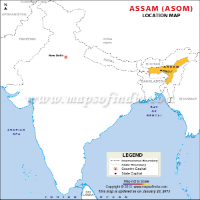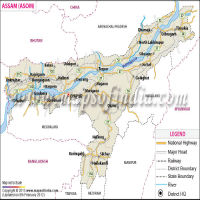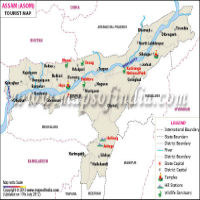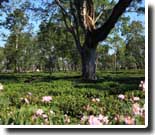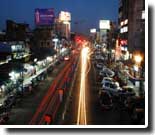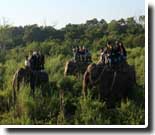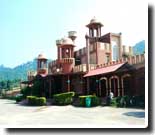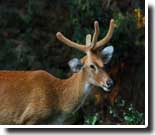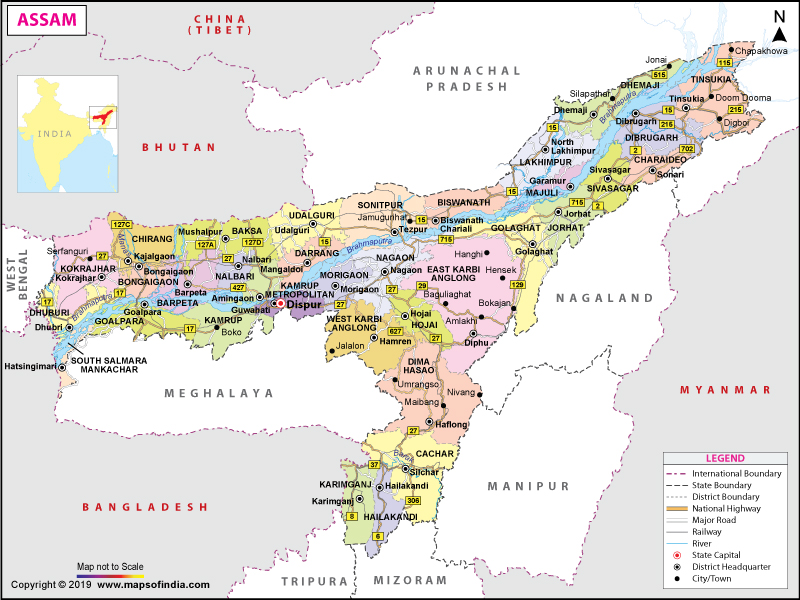
| *Map showing major roads, railways, rivers, national highways, etc. |
| Disclaimer: All efforts have been made to make this image accurate. However Mapping Digiworld Pvt Ltd and its directors do not own any responsibility for the correctness or authenticity of the same. |
Situated in the northeast part of India, Assam is one of the country's best holiday destinations. Assam is one of the Seven Sister along with Tripura, Nagaland, Meghalaya, Mizoram, Manipur and Arunachal Pradesh. Apart from these, Assam also shares its domestic border with the state of West Bengal and international border with Bhutan and Bangladesh. The capital of the state is Dispur.
One of the best known attractions of the state is the Kaziranga National Park. Here one would come across the endangered Indian one-horned rhinoceros, which the state has successfully managed to conserve. The state is also known for the Assamese golden silk called muga which is unique to the state. The first and oldest petroleum resources of the country can also be found at Assam.
On 18 November 2013, former Chief Minister of Assam Tarun Gogoi announced that the song "O Mor Aponar Desh" (O' my beloved land) would be officially recognised as the anthem of the state, that is, the Asom Rajyik Jatiyo Sangeet. The song was composed by litterateur Sahityarathi Lakshminath Bezbaroa and is sung along with the national anthem at government functions and school events. On 15 August 2015, the former chief minister had announced creation of five more districts in the state, which include Biswanath, Charaideo, Hojai, South Salmara-Mankachar and West Karbi Anglong.
The state has been served by many chief ministers, but the longest-serving officeholder is Congressman Tarun Gogoi. He served the state for 16 years - 2001-2016. On 24 May 2016, Sarbananda Sonowal, from Bharatiya Janata Party, was sworn-in as the chief minister of Assam.
| Facts on Assam | |
|---|---|
| Official Website | www.assam.gov.in |
| Date of Formation | 1912 (Assam Province - British India), 15 August 1947 |
| Area | 78,438 km sq |
| Density | 397/Km2 |
| Population (2011) | 31205576 |
| Males Population (2011) | 15939443 |
| Females Population (2011) | 15266133 |
| No. of District | 32 |
| Capital | Dispur |
| Rivers | Brahmaputra, Manas, Subansiri, Sonai |
| Forests & National Park | Kaziranga NP, Manas NP, Rajiv Gandhi Orang NP |
| Languages | Assamese, Bodo, Karbi, Bengali |
| Neighbours State | Meghalaya, Arunachal Pradesh, Nagaland, Manipur, Tripura, Mizoram, West Bengal |
| Official State Anthem | O Mur Apunar Dex |
| State Animal | Gor |
| State Bird | White-winged duck |
| State Flower | Kopou phul |
| Net State Domestic Product (2011) | 30569 |
| Literacy Rate (2011) | 73.18% |
| Females per 1000 males | 954 |
| Assembly constituency | 126 |
| Parliamentary constituency | 14 |
During medieval times, Assam was ruled by two dynasties, Koch and Ahom. While Koch was of the Tibeto-Burmese origin, Ahom was Tai and ruled the northern part of the state. Though India faced a number of invasions during ancient and medieval times, but none was able to subjugate Assam. The Mughals made several attempts to conquer Assam, but were unsuccessful. However, in 1826, western Assam came under the control of the East India Company following the first Anglo-Burmese War. In 1833, the British installed Purandar Singha as the king of Upper Assam. But in the next five years, they completely annexed the area.
Geomorphologists say that the Brahmaputra River is Assam's antecedent river and functions as its lifeline too. The river enters the state from Arunachal Pradesh. Upon entering Assam, Brahmaputra forms many tributaries. The state is rich in natural resources such as petroleum, coal, limestone and natural gas. Apart from these, many minor minerals like clay, magnetic quartzite, feldspar, sillimanites, kaolin, etc can be found here. The western districts of the states also have a meager iron quantity. Gas and petroleum reserves exist in the northern part of the state. These were discovered in 1889.
Assam comprises 32 administrative districts, which are further divided into sub-divisions. The districts are administered and monitored by the district magistrate, district panchayat office, deputy commissioner and the district court at their respective headquarters. The districts are demarcated, depending on hills, rivers and forests in the state.
The District Panchayat is in charge of the district's local governance and rural areas. However, the cities and towns are looked after by the local urban bodies. The state currently has around 26,247 villages. The local urban bodies are known as nagar-somiti (town-committee), pouro-sobha (municipal board) and pouro-nigom (Municipal Corporation). A couple of important cities in Assam are Guwahati, Nagaon, Jorhat, Dibrugarh, Jorhat and Silchar. To keep a tab on the revenue of the state, the 32 districts here are divided based on the area for development projects.
Assam's literacy rate in the year 2011 was around 73.18% with approximately 67.27% female literacy and 78.81% male. The medium of education in most schools and universities is in English. However, in some schools education is imparted in the Assamese language. Like others states, education in Assam includes pre-primary, primary, secondary and higher secondary. Students here are given free and compulsory education by the government till the age of 14. Assam has both state-run as well as private schools. Assam's Directorate of Elementary Education sets the primary school syllabus. Here schools are affiliated to the state board (AHSEC) or the Central Board of Secondary Education (CBSE).
Despite fulfilling 25% of the country's petroleum needs, the growth rate of the state has not been able to be at the same level as India's. Dibrugarh is the second richest district for revenue generation in India after Mumbai in Maharashtra. Similar to the other states of the country, agriculture is the main occupation of the people providing employment to 69% of the population. Apart from agriculture, the state is also a major producer of tea. Assam tea, also known as camellia assamica, is known for its expensive tea leaves and fine taste. Assam also produces sweet potato, potato, turmeric, citrus fruits, rapeseed, spices, rice, herbs, jute, mustard seed, papaya, banana, areca nut, sugarcane, vegetables, leaf vegetables, etc.
One of the most beautiful states of India, Assam is the gateway to the enchanting and unexploited northeastern part of the country. With the majestic Brahmaputra river, magnificent hills and its rich flora and fauna, the state is a tourist paradise. The vibrant life style, the hospitable people and presence of diverse tribes and cultures are some of the characteristics of the Assamese Society. The history of Assam dates back to the ancient times and is also mentioned in the Vedic and Buddhist Literature.
The wildlife sanctuaries in Assam are a heterogeneous mixture of landscapes, plants, birds and animals. The suitable climatic conditions, geographical location and vast forest reserves have made Assam a favorable destination for birds, animals and natural vegetation. Assam is home to several wildlife sanctuaries and national parks that are breeding ground for some rare animals. Many unique species can be found in these wildlife sanctuaries such as Golden Langur and the horned rhinoceros.
According to the 2011 census, Assam had a population of 31,169,272. The state has observed around 16.93% growth in the population in the last ten years. In the years 2021 and 2026, it is expected that the state's population would increase to 34.18 million and 35.60 million, respectively. In 2011, the state's literacy was 73.18% and urbanisation was 12.9%.
As per the People of India project, around 115 ethnic groups are present in the state. Out of these groups, around 69% identify themselves as regional, 19% local and 3% as trans-national. Assam has a large population of scheduled tribes. The state currently has 23 notified tribes out of which Bodos contribute to 40.9% of the tribe's population and 13% to the state's population.
Assam's culture is widely influenced by the Ahom dynasty and Koch Kingdom. One of the major contributions to cultural change is the Srimanta Shankardeva's (Sonkordeu's) Vaishnava Movement. This movement has greatly helped Assam's culture to grow in terms of fine arts, performing arts, language and literature. Assam's language also has the traces of Brajavali language, which was created after taking words from various Indian languages. The British and post-British era has also highly influenced the modern culture of Assam. One can see a blend of north India and the West in the state's literature and performing arts. Some famous dance and dramas include Ankia Naat, Bihu dance, Kushan nritra, Bagurumba, Bordoicikhla, Sattriya, Banjar Kekan, Mishing Bihu, etc. Music is also a tradition in the state with folk songs like Borgeet, etc.
The official language of the state is Assamese and Bodo. Bengali also holds an official status and is a spoken language. Different communities in Assam speak different languages and the state has around 45 spoken languages. Ancient language Bodo was earlier neglected to a great extent, but is now slowly getting recognition. The widely spoken tribal language is Santhali. The people of western Assam speak Rajbongshi, known as Goalpariya or Kamatapuri. A minority also speaks Bishnupriya Manipuri in Barak Valley. One can see people speaking in Nepali in some parts of Assam.
The gateway to the north eastern part of the country, the state of Assam is gifted with lush green meadows, fertile plains, the enormous Brahmaputra river, the beautiful hills, the blue mountains, the wonderful looking tea plantations, the rich flora and fauna. A pleasant climate almost throughout the year and the presence of exciting wildlife resources in the dense forests are added advantages for tourism in the state. It is the home to the famed one horned rhinoceros and few other rare animal species. Thus along with the tourists, it has also emerged as the favorite destination for wild life lovers.
Assam is a hotbed of politics and as such a number of newspapers, magazines and news channels have flourished here. Leading English dailies are The Telegraph, The Assam Tribune, The Times of India and the Sentinel. Assamese dailies include Amar Asom, Asomiya Khobor, Asomiya Pratidin, Dainik Agradoot, to name a few.
The bus service in the state as well as in the adjoining states is managed by Assam State Transport Corporation (ASTC). Started for the residents of the state, there were initially around four buses that ran between Nagaon and Guwahati. Eventually, the network improved and ASTC had better connectivity. North east's only international airport is Lokpriya Gopinath Bordoloi International Airport, formerly called as Borjhar Airport in Guwahati. Currently, only seven airlines are operating. One can get nonstop flights from the airport to 12 cities. On an average, a minimum of 14 international and 315 domestic flights depart every week from the airport.
